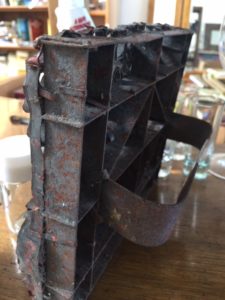 J showed me a vintage iron batik fabric stamp in a tribal pattern for textile block printing. The rust, the wear, and the large handle for the human hand to hold the stamp on flat fabric, tells me the piece is at least 75 years old.
J showed me a vintage iron batik fabric stamp in a tribal pattern for textile block printing. The rust, the wear, and the large handle for the human hand to hold the stamp on flat fabric, tells me the piece is at least 75 years old.
One of the great lessons in appraising objects is the simple fact that old things bear markers of use, and therefore look OLD. This one is somewhat rare, because these antique printing blocks are typically hand-carved from blocks of wood. We especially see them from India, where they are still made.
Other blocks for printing come from Europe or China for the European market, usually cut from wood from the 18th into the 19th century. The patterns on these blocks are somewhat in our European design lexicon. They resemble, for example, the wallpapers of an old historic English or American manor home. Other European blocks were used for European fabrics. These will look like the pattern of a lady’s gown from a by-gone fashion. J’s block has an exoticism that puts it into the ‘tribal’ fabric category.
J’s is older, more intricate, and metal, from Indonesia. The metal indicates this stamp is a masterwork, since metal is harder to work and more expensive than wood. That makes this stamp special. However, these, as a class of objects aren’t worth much, with some notable exceptions. J’s is unique because this particular block was used at the very edge of the fabric, the denser edge at the bottom. We call this metal stamp a “cap.”
The main function of pattern blocks, as tribal art, was for batik fabrics. They used “Caps” to transfer dye-resistant wax to fabric. The applied wax patterns resist dyes and can later be colored. They repeated the process for the more intricate designs.
Because J has a connection with the island of Java, I’m willing to bet this is the origin. The clue is the intricacy of the pattern shown on the “cap” which indicates a certain quality of workmanship. The best workmanship in the batik world comes from that little island. UNESCO designated Indonesian batik as a masterpiece of oral and intangible heritage of humanity. I’m guessing J’s “cap” was used to make a colorful, vibrant design. The pattern I see allowed for variety in color. Plus the centers for such productions, not surprisingly, are the sea-trading centers of Java.
All older batiks have symbolic patterns, and the “good” antique patterns are made from a specific tree that offers differing tones of brown, ochre and yellow, for the dyestuff. Color is important because it indicates contact with foreign traders who brought examples of fabrics from other cultures. J’s “cap” shows such foreign influence, notably in the floral bouquets, perhaps inspired by European fabrics. Other cultural influences came from China and Persia. If you see a phoenix design on batik, you might think of a Chinese trade influence. If you see a peacock, you might surmise a Persian influence;. If you see Arabic script you will know it’s Middle Eastern in flavor, sourced from sea-traders.
The imagination takes over
We don’t know the colors used in the actual fabric, because in this “cap,” we look only at the lines of the pattern. However, the use of a floral motif designates a foreign trader influence, and a foreign palette. Indigo is one of the oldest colors on batiks, and they used it on the most antique of Indonesian batiks. How antique? Experts surmise the tradition of making indigo dye in Indonesia goes back to the 13th century. The first mention in literature of batik surfaced in the 17th century, coming from Malaysia, where history tells of an envoy from the Malay court who was ordered to bring Indian textiles to court. The envoy’s ship sunk, and he brought only four examples. Malay such batiks, because of Islamic traditions, depict no human or animal forms. Floral bouquets such as those seen on J’s ‘cap’ could also be attributed to Malay batiks.
I put a value on this ‘cap’ of $75,. J could most likely sell it to a batik collector, a narrow collectible market. Often, however, these ‘caps’ are collected and made into all kinds of decorative objects. I’ve seen these made into lamps!